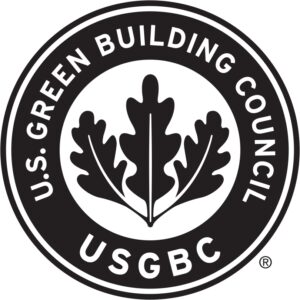LEED v5 BD&C Released
April 2025
Navigate the Latest Updates with Confidence and Expertise
Contributor:
Gigi Lam, LEED AP® BD+C, LEED AP® O+M
Säzän Group Sustainability Consultant

After years of anticipation, the U.S. Green Building Council (USGBC) has officially released LEED v5 for project registration. The new rating system includes updates to the existing credit structure with the addition of new prerequisites targeting decarbonization, health, equity, and resilience. The new updates aim to push certified buildings forward to the ever-evolving forefront of sustainability, while refining the certification process. While projects are currently still able to register under LEED v4 and LEED 4.1, it is anticipated that LEED v4/v4.1 will likely be sunset for registration by early to mid-2026. For AEC and built environment professionals, understanding the key changes to the rating system is imperative in maintaining a competitive edge in the industry and boosting your status as innovators in sustainability. Here’s our rundown of the major changes between LEED v5 and LEED v4/4.1 and Säzän Group’s consulting approach to compliance.
Key Updates in LEED v5
LEED v5 introduces new prerequisites under a dedicated category for Integrative Process (IP). Previously a singular credit, the category now requires projects to complete assessments for Climate Resilience, Human Impact, and Carbon. Projects that have pursued the Integrative Design Credit and Pilot credit for Resilience will already be familiar with the prerequisite requirements.
The Location and Transportation (LT) category, at first glance, seems to have almost no similarities to the previous versions. However, the v5 credits have simply revised the v4.1 credit names to encompass additional compliance paths and improved strategies, making it easier to meet compliance and gain additional points.
One new credit has been added to the Sustainable Sites (SS) category, prioritizing Resilient Site Design and reducing the project’s vulnerabilities to catastrophic natural events. Other existing credits have been updated with more stringent thresholds, which may be more difficult to achieve without diligent documentation.
The major change for the Water Efficiency (WE) category comes with the combination of the Indoor and Outdoor Water Use Reduction Prerequisites and Credit categories into one Water Efficiency prerequisite/credit. Fewer points are available for calculated fixture water use reduction in place of additional options, prioritizing re-use systems or alternative water sources.
Decarbonization is a focus of the Energy and Atmosphere (EA) category, with a new prerequisite focusing on operational carbon and two new credits prioritizing electrification and reduction of peak loads. Points available for certain credits have been reallocated for the new credits. The referenced standards have been updated from ASHRAE 90.1-2016 to 90.1-2019, ASTM E2947-16 to ASTM E2947-21a.
Decarbonization is also a focus for the Material and Resources (MR) category, with a new prerequisite and credit requiring the quantification of and awarding points for reducing the embodied carbon of materials. The low-emitting materials credit, previously in the Indoor Environmental Quality category, has been simplified and moved into the MR category.
Improving health and equity is the focus for Indoor Environmental Quality (IEQ), with a new prerequisite and three new credits focused on biophilic design, accessibility, and resilience for air quality events. Previous credit categories have been combined into one – Occupant Experience.
LEED v5 mainly focuses on reforming v4/4.1 based on feedback from the public and stakeholders, with a better alignment on the shifting industry focus to decarbonization, health, equity, and resilience. Platinum Certification now requires specific credits to be fulfilled, rather than simply meeting the 80-point threshold, focusing on decarbonization in energy usage and embodied carbon. LEED, amongst other certification systems, has been pushing the forefront of what sustainability means in the built environment for decades, and this new version represents the next wave of innovation for the industry.
How Säzän Group Supports You
Navigating the complexities of LEED v5 can be challenging, but with Säzän Group, it doesn’t have to be. Our sustainability consultants are dedicated to guiding you through every detail of the new requirements. Whether it’s strategizing for new prerequisites, optimizing for decarbonization, or documenting for stricter thresholds, our team provides tailored solutions that align with your project goals.
We understand the nuances of green building certifications and are committed to helping you achieve compliance without compromising efficiency or quality.
If you are interested in learning more, you may visit USGBC’s official resources for more information or contact Säzän Group’s consulting team member, Gigi Lam, at glam@sazan.com. The new wave of green building is here, and we are excited to be a part of it.
